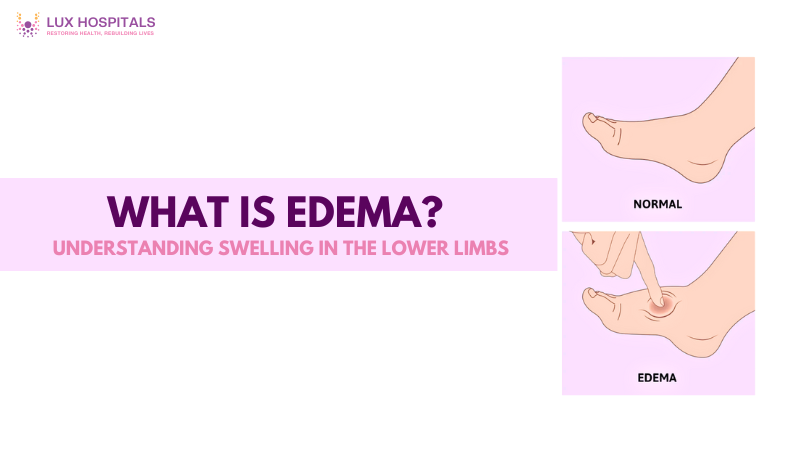Lower Limb Edema: What You Need to Know

Edema is a prevalent illness marked by swelling brought on by excess fluid trapped in the body’s tissues. It most often affects the lower limbs, such as the feet, ankles, and legs, and can range from mild to severe. Better health and mobility can be promoted, and complications can be avoided by being aware of the causes, signs, and treatments of edema. When fluid leaks out of capillaries, which are microscopic blood vessels, and builds up in the surrounding tissues, edema results. This fluid imbalance can be brought on by a variety of things, such as illnesses, drugs, or a lack of exercise
What is Edema?
Edema is a buildup of fluid in the tissues that causes discomfort and noticeable swelling. It occurs when fluid seeps into surrounding tissues from small blood vessels due to illness, trauma, or circulation disorders. While edema can affect any part of the body, the lower limbs are especially vulnerable because gravity naturally pulls fluids downward.
In some cases, edema can be temporary and harmless, such as swelling in the feet after a long flight. However, persistent or severe edema may indicate an underlying illness, including kidney failure or heart problems. Understanding the type and etiology of edema is necessary to choose the best course of treatment.
Types of Edema
Depending on the location and underlying cause, edema can take many different forms:
- Peripheral Edema: Commonly affects the legs, ankles, and feet. It’s often linked to circulation problems or prolonged immobility.
- Pulmonary Edema is fluid buildup in the lungs, often caused by heart failure. Breathing problems may result, necessitating emergency care.
- Lymphedema is caused by a lymphatic system blockage, often after cancer treatment or infection. It results in long-term swelling and skin thickening.
- Cerebral Edema: Swelling in the brain due to injury, infection, or stroke. It is life-threatening and needs immediate treatment.
- Pitting Edema: Leaves a “pit” or indentation when pressure is applied to the swollen area. It’s usually associated with heart or kidney conditions.
Each type of edema presents differently and needs individualized management based on its cause.
Causes of Edema in the Lower Limbs
The lower limbs are commonly affected due to the force of gravity and several contributing factors:
1. Chronic Venous Insufficiency
This happens when blood pools because leg veins are unable to effectively return blood to the heart. In the lower legs, fluid seeps into the veins due to the elevated venous pressure in surrounding tissues, leading to persistent edema. Symptoms may include varicose veins, leg pain, and skin discoloration.
2. Heart Failure
The heart cannot pump blood when congestive heart failure is present. blood effectively, causing fluid buildup in the lower extremities. This is a serious cause of edema and often results in swelling that worsens over the day. Shortness of breath, fatigue, and rapid weight gain may also be present.
3. Kidney Disease
Damaged kidneys may fail to eliminate excess salt and fluid from the body. This imbalance results in fluid retention and visible Edema, especially around the ankles and legs. Protein loss in the urine is a symptom of kidney disease and can further worsen swelling.
4. Liver Cirrhosis
Cirrhosis reduces the liver’s ability to produce proteins like albumin, which helps keep fluid in the blood vessels. When protein levels drop, fluid leaks into surrounding tissues, causing Edema. Ascites (fluid in the abdomen) and leg swelling are common in advanced liver disease.
5. Injury or Inflammation
Trauma, infection, or inflammation can trigger localized Edema in the affected area. This is the body’s natural response to healing and often subsides once the underlying issue is resolved. However, persistent inflammation may lead to chronic swelling and tissue changes.
Symptoms of Edema in the Lower Limbs
Recognizing the symptoms of edema can help with early intervention:
- Swelling in the legs, ankles, or feet that worsens throughout the day
- A feeling of heaviness or tightness in the limbs
- Shiny or stretched skin that may feel warm
- Skin that retains a dent when pressed (pitting)
- Reduced flexibility, joint stiffness, or pain with movement
In severe cases, Edema can limit mobility, increase the risk of skin ulcers, and cause discomfort while walking or standing.
Diagnosis of Edema
Diagnosing Edema involves a combination of physical exams, medical history, and diagnostic tests:
- Physical Examination: A medical professional will measure the amount of edema, look for pitting, and evaluate the state of the skin.
- Blood Tests: These check for kidney, liver, or heart function to identify systemic causes of Edema.
- Imaging Tests: Ultrasound can detect deep vein thrombosis (DVT), while X-ray or CT scans may reveal fluid in organs.
- Urine Tests: To check for protein loss or kidney dysfunction.
A thorough diagnosis is critical for determining whether Edema is a symptom of a more serious condition.
Treatment Options for Edema
The treatment for Edema depends on its underlying cause, but general management may include:
- Compression stockings to support circulation and prevent fluid accumulation
- Elevation of the legs above heart level to promote drainage
- Reducing salt intake to limit fluid retention and pressure on blood vessels
- Diuretic medications (water pills) to help the kidneys remove excess fluid
- Treating the root cause, such as managing heart failure or controlling diabetes
Lifestyle changes, such as controlling weight, exercising, and avoiding extended standing, might also lessen the likelihood that edema will recur.
Prevention of Edema
Healthy lifestyle choices and the management of chronic illnesses are key to preventing edema.
- Avoid prolonged sitting or standing by taking movement breaks.
- Engage in regular exercise to encourage healthy blood flow and lymphatic drainage.
- Maintain a low-sodium diet to prevent fluid retention.
- Stay hydrated to keep blood volume and pressure regulated.
- Wear well-fitted shoes and compression garments if you’re prone to leg swelling.
People with a history of heart, liver, or kidney disease should follow medical guidance closely to prevent edema episodes.
When to see a Doctor?
Consult a healthcare provider if:
- Swelling is sudden, severe, or painful.
- Edema is accompanied by chest pain, shortness of breath, or skin ulcers.
- The swelling doesn’t improve with rest or elevation.
- There is a significant weight gain over a few days.
- You have a history of heart, kidney, or liver disease.
Seeking medical attention early can prevent long-term damage and improve the quality of life for those affected by Edema.
Conclusion
Edema is more than just swelling—it’s often a signal that something deeper affects your body’s ability Regulate fluid. Whether the condition is brought on by circulation issues, organ failure, or lifestyle choices, the first step to effective care is understanding it. By identifying symptoms early and obtaining medical attention, you can save your lower limbs and general health when needed. Living with edema can be challenging, but with proper diagnosis and care, most individuals can manage their symptoms and maintain mobility. Preventive measures and healthy lifestyle choices play a vital role in minimizing flare-ups and discomfort.
Frequently Asked Questions
The leading cause of Edema is fluid leakage from blood vessels into surrounding tissues due to underlying conditions like heart failure, kidney disease, or venous insufficiency. It can also result from a high-sodium diet or medications. The cause determines the severity and location of the swelling.
Compression stockings, lowering salt intake, elevating the legs, and taking prescription diuretics are all part of the treatment. It is crucial to treat the underlying medical conditions, such as kidney or cardiac difficulties. Frequent examinations aid in the condition's monitoring and management.
Yes, dehydration can paradoxically lead to edema because the body retains fluid as a defense mechanism. This fluid may accumulate in tissues, especially in the lower limbs. Proper hydration helps regulate fluid balance and prevent swelling.
Warning signs include persistent swelling, tight or shiny skin, pitting (a dent when pressed), and discomfort or reduced mobility in the affected limbs. If Edema is sudden or severe, seek medical help immediately. It could indicate an underlying serious condition.
If left untreated, edema can be an indication of a dangerous illness such as deep vein thrombosis or heart failure. Infections or skin deterioration may potentially result from persistent swelling. Long-term health depends on early diagnosis and treatment.




















